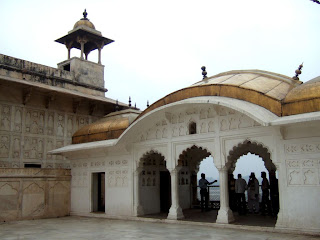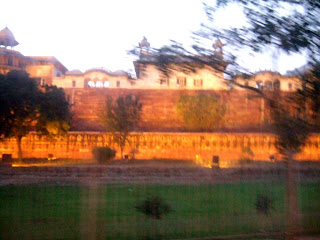
The red Monument was originally a brick fort in a ruin condition but in view of its centralized location, Akbar decided to make it the capital of Mughals in 1558. He rebuilt it with red sandstone with 8000 builders (1565-1573) and took 8 years to complete this imperial city. The existing appearance took place during the reign of his grandson, Shah Jahan who also built Taj Mahal at the same time for his demised wife . He liked to construct buildings with white marble inlaid with gold and precious gems. The Mughal Emperors lived here and governed the state from here as well. The Fort contained the largest treasure and mint that attracts the visits of tourists, travelers and foreign high dignitaries.
There are four gates at four directions but 2 were sealed up by walls and now Gate Amar Singh (center) was the only entry allow to enter into the complex.





Agra Fort was also one of the site in one of the battles during Indian Rebellion in 1857 resulting the rule of Britain in India for a century



There was a splendid gateway leading to an interior courtyard which was surrounded by grand halls covered with profuse carvings on stone, heavily fashioned brackets, piers and crossbeams



Jahangiri Mahal was the most important building of Akbari period and most noteworthy building in Agra Fort. It was built by Akbar and named under his son Jehangir who was the throne heir then.



Jahangir's Hauz in front of the building complex, was a mobile circular stone bowl with diameter of 8 ft by 5ft in height. It was built by Jahangir in 1610 AD. The Hauz carved with Persian verses but hardly can be recognized. Most probably it was used to contain fragrant rose water and transported from place to place for bathing.



Jahangiri Mahal was built between 1556-1605 as a principal Zenana (woman) palace for Rajutput wives of the Mughals.


The great central court was with decorated columns and pillars and most carving and design are in pure Hindu ornamentation.




The Indo-Persian styled decorations at windows, doors and walls.








The 6-ankles diamond sign of Hinduism was found at the top side of one of the structuring building.



The crimson colored Agra Fort situated on the bank of Yamuna River at the center of the city was the residents of past three great Mughals Akbar, Shah Jahan and Aurangzeb. Each of the emperor made significant structural contribution to the complex.



The Pearl Mahal for ladies of royal family at court.

The ancient air ventilator on top of the door and the destroyed area.



The Fort encompasses within 2.5 km long enclosure walls in which some fortification wall originally was full of water and far end was the river bank of Yamuna River.




The beautiful ceiling and entry door at Muasaseum Burz and an ancient wooden door at ladies Dormitories corner. Many present Asian homes inherited design of such kind.



Muasammon Burz was an octagonal towel built with marble balcony with an excellent view of Taj Mahal. Wall, ceiling and column were beautiful decorated and inlaid with precious gems and stones. Accompanied with Shah Jahan in this pavilion when he was house arrested by his own son, was his daughter Jahanara and his fabulous collections of jewels.



The Muthamman Burj was built 1632-40 AD and was the place in the Fort where Shah Jahan was imprisoned by his son Aurangzeb and spent his last 7 years of life, gazing fondly at the tomb of his beloved wife, Mumtaz Mahal, over the other side of Yamuna River. Macchi Bhawan once had a pool and fountain, was the enclosure for harem functions.


The pretty decorated wall and ceiling at Muasammon Burz




The marble pavilion balcony of Muasammon Burz where Shah Jahan died in the year 1666 AD.


Dormitories of emperor's concubines were surrounded by a central courtyard and along the wall were candles holder to light up the whole square at night. The central court was the ladies' Bazaar allowing pavement hucksters to display and sell their wares like silks or finery to Muslim Noblewomen for the royal ladies.


The Khas Mahal is one of the best white marble palace with paintings on marble and is the representative structure of Islamic + Persian features.


Elegantly designed white marble wall at Khas Mahal.


The Hall of Public Audiences (Diwan-I-Aam) .


The Hall Of Private Audience (Diwan-I-Khas) where the emperor held forth on important matters of the state on a splendid peacock throne.



Amber Fort while glittering in golden light at night looked so stunning at the center of the city.



Another appearance of Amber Fort in the evening sunset beam.




Thank you for all the pics and info, very kind!
ReplyDeleteHope you enjoyed!
ReplyDelete
ReplyDeleteAwsome information thanks for a sharing a interior designer in faridabad information.
interior designer in faridabad sector 12
interior designer in faridabad sector 13
interior designer in faridabad sector 14
interior designer in faridabad sector 15
interior designer in faridabad sector 16
interior designer in faridabad sector 17
interior designer in faridabad sector 18
interior designer in faridabad sector 19
interior designer in faridabad sector 20
interior designer in faridabad sector 21
interior designer in faridabad sector 22